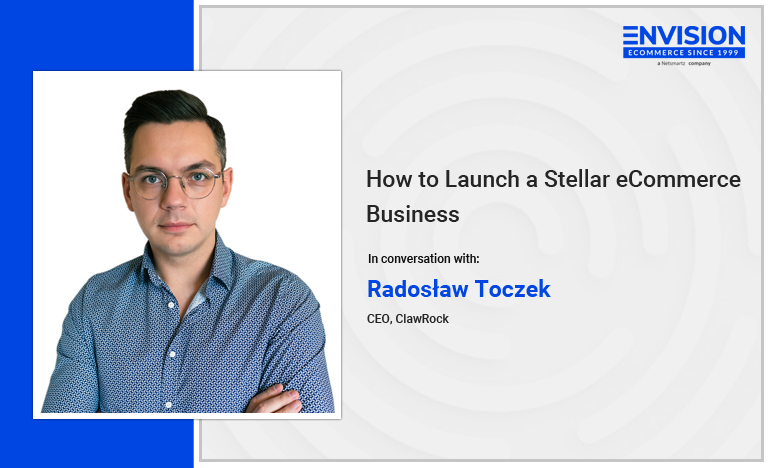How to Launch a Stellar eCommerce Business: In Conversation with Radosław Toczek
We are living in 2022, and building or managing an eCommerce business at this time requires stellar planning and right implementation. With increasing consumers’ expectations, it has become difficult for entrepreneurs to nurture relationships and build brands.
To know how it can be done successfully, we interviewed Radosław Toczek, the CEO of a leading eCommerce agency and an expert Magento developer. This discussion will be very insightful and full of valuable tips and tricks to grow an eCommerce business.
So let’s get the talk started.

Who did we interview?
Radosław Toczek is the CEO at ClawRock, a leading eCommerce development organization. With a demonstrated history of working in the internet/eCommerce industry, he has helped many budding entrepreneurs turn their businesses into brands. His expertise lies in technologies like Magento (all versions), Symfony, Laravel, Zend Framework, and many others.
Q1: What exciting projects are you working on at present?
We are currently working on some exciting projects. The two most interesting projects are CD Projekt Red Store (PWA) and the other is a very complex project for one of the biggest Polish catering companies – Diety od Brokuła. We have different challenges in both projects, but both clients are very open to new functions, continuous improvement, etc., making our cooperation smooth and developmental.
Q2: What is the right way to build a robust eCommerce platform that delights users? And, how shall startups or SEMs approach eCommerce development?
I believe an eCommerce platform must be easy to extend and configure. The architecture and each new feature should be stress-tested regularly to avoid bottlenecks when clients start using the platform with real data.
Users who spend the most time on the platform are admins who are responsible for managing the eCommerce business, and from their point of view, the interface has to be nice and easy to use. To delight these users, startups need to invest in the appropriate UX/UI phase with mockups, user tests, etc.
From the external developer’s point of view, there must be a clear path to extending the platform. They must see those core developers care about the quality of the code and that at least all the SOLID principles are met.
If the platform is a SaaS or PaaS, then a strong focus should be placed on infrastructure and its automation. Setting up a new eCommerce store should be possible with a few clicks and a few minutes of waiting.
If the eCommerce business can self-host the platform, all configurations and tutorials must be included in the documentation. The best scenario is to prepare a copy-paste configuration. This is very important because when a potential client has problems with installation and configuration, it is very easy to abandon the platform and go for something easier to start with.
Q3: What factors should be taken into consideration when choosing a tech stack for an eCommerce project?
The most important, in my opinion, are:
- Availability of developers and software houses,
- How strong is the eCommerce platform community,
- The popularity of the programming language – I will rather focus on well-known languages, i.e., PHP.
Thanks to this, the client will not depend heavily on several developers or one software house.
When choosing an eCommerce platform, it is worth checking if the latest version of the LTS tech stack is used. It is worth checking out the Roadmap and upcoming releases to verify if they reduce technical debt.
It will show you what is new in that tech stack (better performance, for example) and how quickly the eCommerce platform creators can adapt it to the latest version. If the time is really long, it can show how much technical debt is.
Q4: What common challenges do businesses usually face when embarking on an eCommerce development journey? And, how shall they plan to minimize risks?
The biggest challenge in development is the lack of a plan/documentation of what the business would like to achieve. Most development or UAT phase problems are due to expectations that are not properly described in the documentation. Often, functions are described in a few words.
Nothing is wrong if a business doesn’t have the proper documentation until it’s willing to go through the discovery phase and has time to cover all the key features and integrations.
Sometimes, a premature decision about a tech stack or platform can also be very problematic and cause far more developer effort than usual in similar projects. The most common mistake is the wrong decision about the eCommerce platform, which may be inflexible or surprisingly too flexible (requiring more work from developers, which is unnecessary in a regular store).
Q5: What are your thoughts about popular eCommerce technologies like headless commerce and PWA? Are they for all types of businesses?
No, these technologies are definitely not for everyone, especially not for businesses with a small development budget. First of all, to properly create a PWA application, you need to find a really great team that will be able to build an appropriate application that will allow you to install apps on the phone, work offline and use hardware functions. Without these features, businesses will end up with more expensive regular websites that pretend to be PWA.
Secondly, the choice of the backend is also crucial. You can have the best PWA, but if you have to make a lot of API requests to get simple data, you might end up with a PWA slower than a regular website.
For companies with larger budgets and no native app, I think the right path is to choose headless commerce and PWA.
I think a good, responsive website with Google Page Speed > 90 and lightning-fast loading time is enough for small businesses. If they have big plans for the future, they might consider building a PWA frontend later, but then they should check if the backend platform has an API prepared for it.
Q6: Any specific tips that you would like to provide for budding eCommerce developers, brand owners, and others juggling to build an eCommerce business?
To fully answer this question, I have to divide my answer into two parts:
Brand Owners:
- Start by researching what works for you and what the biggest players in your industry are doing
- Invest a lot in the implementation of Google Analytics and Google Tag Manager to know what is going on in your eCommerce business
- Do not produce a feature that will cost you a lot of money and won’t increase your sales – do the research first!
Developers:
- Just focus on one or two eCommerce platforms and learn them well
- Always write code that follows well-known coding standards
- If the platform has its own coding standards, please follow them
- If you have time and the platform is open-source, contribute to its development
Wrapping Up
So, that was all about today’s session. We thank Radosław Toczek for talking to us and sharing essential insights about the industry. We hope you find this session insightful! For more critical discussions and insights, subscribe to our content and stay updated with what’s new in eCommerce and Magento.











